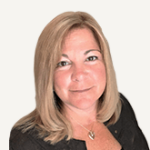Watch the episode here:
Listen to the Podcast here:
About Kim Moceri
 Kim Moceri joined Francisco Partners Consulting in 2020 and is an Operating Partner with a focus on Customer Success and Professional Services.
Kim Moceri joined Francisco Partners Consulting in 2020 and is an Operating Partner with a focus on Customer Success and Professional Services.
Prior to joining Francisco Partners Consulting, Kim most recently served as the Head of Worldwide Customer Success, Customer Support and Renewals at ClickSoftware. While at ClickSoftware, Kim was responsible for building a world-class Customer Success and Support organization delivering consistent global services to meet evolving business and customer needs and driving a high-level of customer loyalty.
Kim was also a key leader in the due diligence efforts of the successful sale of ClickSoftware to Salesforce.com, Inc. (NYSE: CRM).Prior to ClickSoftware, Kim spent over 20 years in various customer facing and operations roles responsible for managing all aspects of the global post-sale customer lifecycle. Kim spent 14 of those years with RSA Security (a subsidiary of Dell/EMC) responsible for a P&L of $260M, over 18,000 customers and a large product portfolio.
Kim has a strong passion for customers and delivering an exceptional customer experience. She brings deep experience in a wide variety of operating models from on-premise technology to software-as-a-service (SaaS).
Top-Down Strategic Customer Success With Kim Moceri
How To Help Customers Achieve Their Business Outcomes
We are excited about this show. We have with us Kim Moceri. She is the Operating Partner of Francisco Partners. I’m excited to have this conversation because as we were prepping for this she was talking about how she moved from an operational role in customer service and customer success into a very strategic role. She’s got some really deep insights that we’re going to talk about. One in particular that I’m excited about is her engagement framework that we briefly touched on so I’m looking forward to exploring that some more.
Let’s go ahead and dive right in. There’s a lot of great stuff to talk about. Kim, welcome. Thanks for being here.
Thank you for having me.
Kim, we know a little bit about your background, but you’ve got an interesting history, all things customers. Can you walk us through your background and how you ended up at Francisco Partners and then a little bit about the work that you’re doing there?
Most of my background has been customer-facing to start with. I went to school for court stenography, so I wasn’t expecting to be in this technology world that we’re in. While I was studying for my state board, I started working in a software company as the customer service person answering the phones and routing calls to the customer support team. I became intrigued with customer support problems and working with customers. From there I got in many different customer-facing roles. I spent a lot of my career at RSA Security, a cybersecurity company, working from being a Technical Account Manager to managing large organizations that were focused on customer support and customer success. From there, I spent time going into operations, learning a lot about the business but missed working directly with customers. I went back into the customer support world. I was managing over a 300-person organization and driving the importance of not just being a tactical support organization, but also building that relationship with customers, being more consultative, and helping customers get to their outcomes.
Get out of the reactive mode and be more strategic with your customers.CLICK TO TWEET
From there, we had a former CEO that had gone to a startup company, ClickSoftware. I wasn’t looking to change my career. I enjoyed what I was doing and being in the cybersecurity world. What intrigued me about this opportunity at this startup company was they were working in field services. What excited me was that all my career, I loved working with customers and solving their problems, but this was a unique opportunity where the way we serviced our customers would affect how they would service their customers. Not only was it important that we had to offer our customers a good experience because if we didn’t we affected how they did business with their customers. That intrigued me and brought me into the field services world. It was a Francisco Partners-owned company and that’s how I became affiliated with Francisco Partners.
Talk us through the work that you’re doing, how you’re helping portfolio companies, and how your background is helping them with the work that they’re doing as well.

Strategic Customer Success: Become strategic to your customers and help them throughout the life cycle to build loyal customer relationships and ongoing long-term relationships.
The Francisco portfolio companies are like my customer now. I’m working with them to drive best practices across the services side as well as customer success. We have anywhere between 45 to 50 companies that we own and invest in. Customer success is probably only known in about maybe ten or fewer customers. They are more focused on professional services and support. I’m trying to drive the importance of customer success and how you engage with your customers and focus more on their outcomes. Not just customization and take a case, file a case, next case, but how you can become strategic to your customers and help them throughout the life cycle to build those loyal customer relationships and ongoing long-term relationships.
Kim, what do you see as one of the common threads with those companies that you’re working with on customer success that you see they are all challenged by?
They’re all challenged by, and I was challenged with this myself at ClickSoftware, being reactive and not understanding that it’s about building that strategic relationship. If you focus more on the adoption and the use of the solution and understanding what they consider success, then that will lead to retention and a long-term relationship as well as huge expansion and cross-sell opportunities. It’s more around getting out of that reactive mode and being more strategic with your customers, and understanding the engagement that they want with you.
That’s such a key thing here. We see many people in the customer experience world and the customer success world talking about journey mapping and some tactical things. They are important but a lot of people, even a lot of the experts, never get to a true strategic level when they’re looking at the customer journey and at customer success as a whole. Could you take us through what’s your perspective of the customer journey from a strategic perspective?
It is working with them on understanding their success plan. Why did they buy the product in the first place? What are their objectives? Most of the time, we’re being tactical and customers are calling us. We’re trying to solve a problem and then we move on versus understanding what they consider success. What are those different touchpoints throughout the journey? Most of the time, we focus on that post-sales activity. When they are on-boarding, that’s the most critical time. It’s understanding the success plan and working with them to drive those success plans, which allows you to be more strategic versus reactive. When you on-board them, understanding why they bought it, identifying what those measures are for them, which will drive the behavior and how you engage with them. You’re identifying and acting on those customer triggers based on what you identified at the onboarding phase.
Kim, take yourself back to several months and what your world looked like then versus what it looks now as we’re coming out of COVID. What are some of the big transitions, changes, or dynamics that have been very notable to you since we’ve been dealing with the pandemic?
It’s realizing how you stay engaged with your customer. If we look at a customer success framework, which includes professional services, most folks thought that you couldn’t be successful unless you were building those relationships by being on-site. That was how you build long-term relationships. The things that we’re seeing is that you can build relationships by being remote and that not everything needs to be on-site. It’s important that you identify those engagements and how the customer wants to be engaged and maintaining that journey for them by driving certain triggers, creating the right content, creating those right engagements with webinars and self-service, and all of those things. People have realized they have to be more self-sufficient where people weren’t available. If you can build that content and create that model that is solving customer pain points, then you’ll build that long-term relationship and have that strategic customer that’s willing to work with you.
Engage with your customers. Focus more on their outcomes, not customizations.CLICK TO TWEET
As a follow-up to that question, what are you seeing that customers are preferring? Are they preferring more of the remote, the customers themselves, or are they looking forward to having more of the face-to-face engagement? Tony and I have talked about this as well. We’re seeing it all over the board. It depends and I’m wondering if you’re seeing the same thing.
It depends. More people though are going to go the remote way because that’s the way people are satisfied in doing business. We have to listen to our customers. I know certain portfolio companies are increasing their rates if they require on-site, which is driving more to that remote. You have to make sure that you can still drive that proper engagement when you’re doing the remote. It’s possible, for sure.
It comes back to those success metrics and understanding on the front end what does success mean not just for your client companies, your portfolio companies, but also for their customers, and can you deliver on that from a distance from this remote setting. It’s interesting because your particular background speaks to how you were doing this very early on. You talked with us about ClickSoftware and how you had this particular way of engaging with the field representatives. It was almost like a direct connection to the people that were in the field. Talk a little bit about that experience and maybe what you learned from that that you can apply now.
Normally, we wouldn’t talk to the field representative. ClickSoftware is a field services software company. We helped utility companies, big telecoms and big healthcare companies juggle complex logistics, rising customer expectations and the high cost of on-site operations. We had some issues and pain points in our products. It was important that we not only work with the administrators of the system but to get on the phones with the field service reps while they were at the customer site. See the challenges that they were experiencing when trying to deliver their product to the customer, how they interacted with the customer, and how our product was hindering their ability to get the job done seamlessly.
It was important to have that connection. We were talking to folks that were picking up hospital beds and making sure new hospital beds were getting placed in the right room. They didn’t have access to their mobile device to even know where it went. We were becoming a high cost to serve, which was the complete opposite of what we were trying to do. It was a great experience to be able to get in front of those people that were doing the day in and day out job, and how the interruptions in our service were affecting them to be able to do their job and service their customers. It was a great opportunity to fix those pain points.

Strategic Customer Success: Onboarding is the most critical time. Work with your customers to drive those success plans, which allows you to be more strategic versus reactive.
There’s an element there of lean thinking or lean manufacturing, which is all about getting out there on the floor and seeing what’s happening. We step away from it in the service world far too often and we try to do our journey maps and things in theory on the whiteboards. There’s a lot of power in being there, whether it’s remote and seeing what’s happening, or whether it’s being right there side-by-side with your customers as they go through the journey. That’s a great story. Thank you for sharing that one with us.
Kim, we talk a little bit about the need to be more proactive but what are some of the other mistakes or challenges that you see in general with the engagement process? What are some of the best practices that you’re sharing with the companies that you work with?
Some of the best practices that I’m trying to enforce across the companies that I’m working with is the importance of identifying the right charter, which is focusing on adoption and the value that the customers are getting out of the solution, which will lead to retention and those upsell and cross-sell opportunities. The bigger thing is also ensuring you’re getting the support from the top down. We see a lot from the post-sale side that we’re trying to drive this initiative all on our own. When you start a customer success team or function, the company thinks you own it all. It needs to happen from the top down. In most of the portfolio companies where we started on this journey, it’s the CEO that has reached out to me and it has been 100% bought in. That’s where we’re seeing absolute success and the right framework being driven and built because it’s a company initiative. Even though the function is owned, everyone realizes they’re responsible for customer success throughout the journey.
I love hearing that because that’s something that we are doing a lot of talking about too. It’s the importance of the executive team engagement with customers in whatever form that means, whether it’s strategically engaging through a customer advisory board or being involved in the customer success journey. Tony has tons of stories about how that filters down all the way to the user level and customer experience and having that executive support for the initiatives that they’re trying to do. That includes budgeting and human resources and all of those things. I love that you brought up the point about executive support and it’s starting at the very top with the CEO. Kim, what are some of the things that are on the radar for you moving forward?
It’s getting this across the portfolio companies. Even though we would say customer success is pretty new, it started around 2014 or 2015, it’s not new. It’s different from account management. A lot of companies that I’ve been working with will say, “We have customer success,” but it’s an account management function within the sales organization. That is very different from what customer success is, building and retaining those loyal customers. On the horizon is educating and understanding that you should be focusing on business outcomes and being strategic.
Is the biggest difference between account management and customer success focusing on the business outcomes versus making sure that everything’s working okay?
That’s one of the main things. It’s focusing on those outcomes because sales does want to solve a problem for you. They’re selling you something to solve that problem, but then there’s no one focused on helping the customer realize that value and realize those outcomes. Some of the folks at these portfolio companies that have these teams are saying, “I’m preventing churn,” but they’re preventing churn by working on renewals. It’s not about that. It’s focusing on what is your solution providing the customer and what does the customer consider success?
It’s interesting because it’s more than just ease of use and some of the experience things that we’ve been focused on for many years in the customer experience world. When you talk about education as one of the leading differences in customer success and focusing on that, that’s about transformation. That’s about teaching people new skills and capabilities. Maybe teaching them about what the software can do but also teaching them how they can use it for their benefit to achieve those goals at whatever level they are in the business. They’re achieving that particular goal and it goes up all the way to the top of the company. It’s fascinating to start talking about this from that transformational perspective. Customer success is pushing us beyond the experienced economy into what Pine and Gilmore called the transformation economy.
Our customers are the products now. As we educate them, they go from being the raw material to the finished product. They become skilled in a new way and can achieve new things. A lot of times what I’m finding is there’s a lot of coaching that goes into this process as well. We’d seen even in that personal development world that’s been around for many years now, there’s an element of that type of flavor to customer success when it’s done right. Was that what you’ve seen as well?
Yes. It goes hand in hand, which we haven’t talked about because we talked a lot about the engagement model. It’s having those insights. It’s not only rallying the company around the customer’s journey but what insights do you have? How do you know if the customer is healthy? Another thing that I’m seeing with my portfolio companies is they’re taking the inside view out like, “I need to do this and we need to do this, and that makes a healthy customer.” I’m challenging them to test that. Let’s look at what insights you’re gathering. Are those showing that the customer that churns, would that show up as red? The ones that you think are healthy, are these insights showing that it’s green? It’s making sure you have those right indicators, insights and predictions to show the right health, and taking that outside-in view. That’s the difference in how people need to look at things as well.
The value your customers get out of the solution will lead to retention and upsell and cross-sell opportunities.CLICK TO TWEET
That’s a great perspective to have. We’ve covered a lot of ground and I have enjoyed this conversation because it’s one that Betsy and I have had to some extent already about strategic customer success, but we’ve just taken it to a whole new level. I particularly liked the point about focusing on the business outcomes with education. How do we help the customer achieve that? That’s one of the biggest things I pulled out of this interview. What about you Betsy?
It’s the same. That executive focus that filters all the way down through the organization is so key to making sure that you’re getting the business outcomes for your customers. Sometimes there’s so much focus on getting your own business outcomes that you forget that the way you get your own business outcomes is to focus on your customer’s business outcomes. I enjoyed that piece of it.
If there’s one thing that we can leave the audience with that you want them to know, what would that be?
Stay strategic and understand how customers want you to engage. Something that I see is being pulled down into the tactics of making sure customer support problems get solved. That’s not what a customer success manager should be. Stay strategic and understand the success plans and move forward. Sorry, if it’s a broken record but that’s the important part.
It’s important to repeat because that is key.

Strategic Customer Success: Not everything needs to be on site. You can build relationships remotely. What’s important is that you identify those engagements and how the customer wants to be engaged.
On our show, we love to give our guests an opportunity to give a shout out to a nonprofit, a charity or some organization that’s doing good things for the community. That’s important to both of us to share on our show. Is there an organization that you’d like to talk about a little bit?
I learned about this foundation, Be Like Brit. It’s a nonprofit foundation from a former colleague of mine at ClickSoftware. Her family started this nonprofit organization to serve the children of Haiti. This was started by the family where her niece, a nineteen-year-old girl, went over to her college to work with the children of Haiti and saw how happy they were, and they didn’t have anything. In unfortunate circumstances, she died in the 2010 earthquake while she was over there. The day before this earthquake happened, she had texted her parents and said, “I want to live here and start an orphanage for these kids.” The family made that happen. There’s a 19,000-square foot home that 66 children from Haiti live in. They help and build the future of Haiti with these children. That’s something I can stand behind.
What an amazing story and a great legacy for their daughter. Thank you so much for telling us that story.
Kim, what is the best way for people to contact you if they want to reach out to you?
I’m on LinkedIn as Kim Moceri or I can be found even through Francisco Partners’ website. Feel free to link me in and I’ll be happy to connect.
Kim, thank you so much for joining us. We appreciate it. This was such a great conversation with so much really important, robust information that you shared with us.
Thank you for having me. I appreciate it. It was fun.
—
This interview is one of the most significant ones we’ve done at least in a long time. I say that because of the focus on strategy, we’ve heard that word so many times in this episode. The strategic focus that a CEO needs to have, and that the customer, whether it’s customer support or customer success, whichever role, that VP or that director, they have got to be thinking at that strategic level. They’ve got to be thinking about it from the top down because if they think from the bottom up, they’re never going to get to strategy. They’re just going to get caught up in the day-to-day reactive, fixing problems, and they’re never going to get out of that mode.
It’s a funny little mental graphic that you can come up with, top down and outside in. To get to the core of everything you got to go top down and outside in. She hit that point so well and articulately to really stress the importance of that. Now more than ever, as things have changed so much in understanding what was strategically important to your customers a few years ago may be very different now, and how much more meaning that has now post–COVID.
She said this several times about education. Once you know the business outcomes that your customer desires and understand strategically how you can deliver those, then it’s about educating, educating, educating. She threw out there webinars, training and all kinds of different ideas very quickly. If we went in-depth with that, we could discover that there are a lot of things that companies can do, even if they’re not in a customer success mode or they’re not a technology company. There are a lot of things they can do to help their customers be successful and achieve the goals that their customers want.
It is the whole proactive thing. You’ve got to constantly be focused on that. I thought it was a wonderful interview and I know you share the sentiment that we’re very grateful that she took the time to spend with us.
That’s a wrap for another episode. Thank you again for joining us and we’ll see you next time. Bye, Tony.
Bye, Betsy.
